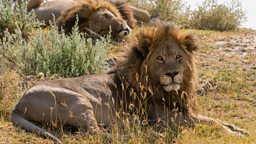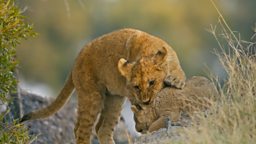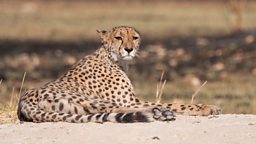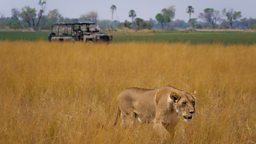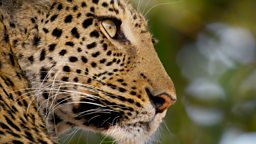Cat spotlight: Colin and Nkgonne
By Dr. Robynne Kotze, University of Oxford (WildCRU)

It’s late afternoon, and Gordon and I are with the sub-adult male lions of the Xudum Pride, brothers Colin and Nkgonne who are almost 2 and a half years old. It’s time to switch over to night-time filming – something I’m very excited about as this is the first time I’ll have the opportunity to watch lion behaviour firsthand after nightfall.
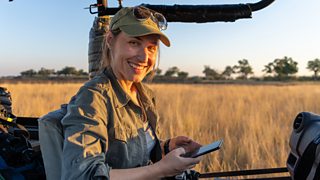
I have been studying lions in the Okavango Delta for more than 10 years and I put a GPS collar on Colin back in July 2022 as part of my current research. Having fallen in love with big cats at the age of 5 I single-mindedly pursued a zoology degree to get here, but most of my observations of lions have ended at sunset when it’s time to think about setting up camp for the night.
Suddenly, I hear something padding past on the hard clay. We do a quick scan with the handheld night scope, looking for telltale heat signatures of the rest of the pride. Sure enough, they materialize from across the floodplain. “Why would they bring the cubs over to the young males? Do they even realise Colin and Nkgonne are here?” Gordon and I excitedly speculate. The two boys have already been chased by the adult females on a few occasions, a clear sign that it’s time for them to leave the pride.
As the cubs protest their hunger with their characteristic yowling, the lead lioness Mmakgosi walks straight up to Colin and Nkgonne. The night erupts with roaring and growling as the other adult females rush the boys and give them a beating – paws flailing, and teeth bared. Nkgonne recognizes he is not welcome and quickly disappears behind a nearby termite mound. Colin, however, holding his nerve, quickly shrinks himself into a submissive posture, ears back and head to the ground between his paws, not daring to challenge the adult lionesses.
This type of interaction with their mothers is not uncommon when sub-adult males are around the age of 18 to 36 months. Now the mothers have come back into estrus and mated, their priority will be feeding and protecting their new litters. Also, by this age, the boisterous young males will have started testing the boundaries of their strength, often practicing their fighting skills on their littermates and even challenging the older lionesses.

We had already observed Colin confidently striding towards an adult female and lording over her – chest out and head held high - as she sunk down to the ground and hissed and spat at him. While this behaviour is good practice for Colin when he will one day have to take over and subdue a pride of his own, this is not the kind of behaviour that wins you popularity in the family, especially when young vulnerable cubs are around.
telltale signs that the boys will soon be chased out of the pride
These interactions are the telltale signs that the boys will soon be chased out of the pride for good by both their fathers and their mothers, each for slightly different reasons. By their fathers because as they age they become a threat to taking over the territory. By their mothers because larger boisterous males are likely to displace younger cubs at the dinner table.
This sex-biased dispersal in lions – in which males leave their prides of birth and females remain and inherit the territory - is an important mechanism to avoid inbreeding. If males were to stay in the prides in which they were born, they would inevitably end up mating with their mothers and siblings, and in the long-term this can have negative effects on survival and weaken the gene pool.
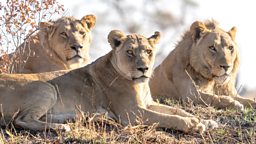
With their enormous paws that they are yet to grow into and their developing scruff in the form of blonde-chest hair and mohawk hairstyles I find it hard to not feel sorry for Colin and Nkgonne in this period of their lives, as they walk the tightrope between acceptance and eviction. Their boisterous nature and basketfuls of (sometimes ill-advised) bravado make them incredibly endearing, and this is why I enjoy observing young males so much.
they walk the tightrope between acceptance and eviction
Younger siblings and age-mates alike usually receive the brunt of their rough and tumble advances where wrestling, ankle-tapping and tackling are all part of the training needed to become efficient hunters and efficient fighters. Their interactions with each other are just as important - while the two are in each other’s company they are in constant contact – sleeping side by side and head-rubbing to affirm their blossoming coalition. This interaction is important in developing their lifelong bond, as they will instinctually stick together and rely on each other to survive.
I started collaring young dispersers in the Okavango in 2017 towards the end of my PhD, in the same year I joined the Wildlife Conservation Research Unit (WildCRU) at Oxford University. What happens to dispersers after they leave their pride became a burning question for me, and joining WildCRU allowed me to fit in answering that question with their wider programme of securing lion corridors.

Following the satellite data from Colin’s collar, it is becoming clearer that our two young males are spending more time in the far south of their pride’s range, away from the core area, likely to avoid their fathers. They are also doing exploratory excursions to the north, going beyond the boundaries of what is known and periodically returning to the safety of familiar territory. From now until they are in their prime at around 5 or 6 years old they will be in a state of territorial limbo.
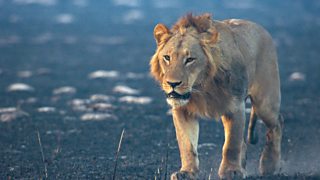
This period of a young male’s life, which is referred to as dispersal, is when young males leave the area in which they were born and move into more unfamiliar lands. While ultimately taking over a pride of females of their own is the end goal, until they are strong enough to challenge and evict resident males their movements will be determined by a combination of avoiding conflict with larger males and finding opportunities for successful hunting. From the satellite data, this often looks like long straight movements in any one direction as they remain on the move, unable to settle in a ‘safe’ territory.
Males at this age are also typically less averse to risk, including risks posed by interactions with people like predating on cattle – ‘easy prey’ compared to a deadly buffalo. This could lead to retaliatory killing, as people fear lions and want to protect their livestock. Lion mortality rates during this phase of life are therefore quite high, which can be problematic if young males are the carriers of useful new genes to other cores of lion habitat. Today, there are few wild lion populations that are large enough to be self-sustaining, and the introduction of new males into an area is important to maintain genetic diversity of the remaining populations.
In areas like Botswana, where many national parks and game reserves remain unfenced, young males can potentially move between different protected areas through what we call wildlife corridors. In practice, a corridor is simply an area that is permeable to the movement of, in this case, lions. In such areas, helping people to protect their livestock against predation is the best way to ensure that lions can move through a landscape unharmed. If livestock is protected, particularly at night when lions are most active, there is less chance of predation. Consequently, lions will not stick around because they do not have access to this food source and if no livestock are lost people have less incentive to track and kill lions.

Collaring young males and tracking their movements during this transient phase in their lives is a good way to understand how they respond to novel habitat. When this knowledge is used to model potential routes for lion movement, we can identify corridor areas that will most likely be used when lions leave protected areas in search of new females. This can then inform conservation planning and the allocation of resources to these key areas to help reduce the chance of conflict and so facilitate safe passage of lions. The data from Colin’s collar will form part of a body of information that will help us understand how lions from the Okavango Delta disperse in the search of new territories.
conservation is about what happens to individuals like Colin on the ground
While this data will feed into a much larger study identifying and protecting corridors for lions, getting to observe first hand Colin’s interactions with pride members during this phase of his life is invaluable. As we quickly move towards a world of automation and examining ecosystems from a bird’s eye view afforded by satellite technologies, conservation is about what happens to individuals like Colin on the ground.
He is one lion in a large population, but that population is made up of individuals whose genetic contributions are important for the survival of the species. Understanding individuals and being given the privilege to document the highs and lows of their stories is ultimately what helps us empathise with these enigmatic animals. In the words of Baba Dioum, "In the end we will conserve only what we love; we will love only what we understand; and we will understand only what we are taught." After watching Colin and Nkgonne navigate this important phase in their lives, I can’t help but secretly root for their success.
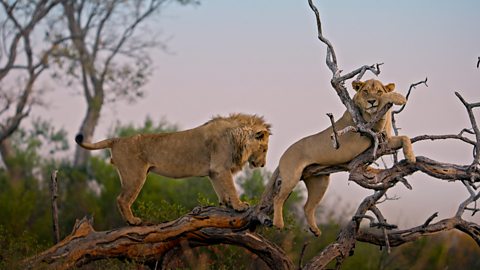
Two young lions lounge around in a tree
Sub-adult male lions Colin and Nkgonne try to relax, balanced on the branches of a tree.
